Growing nertera in a home or office
Nertera is a ground cover perennial plant. Some species can be grown outdoors, but only in mild climates. When grown in a city apartment, this plant is also quite picky. As a rule, “coral moss” lives with careless housewives only one year. But nerte lovers can create conditions under which the plant will delight the eye with its fruits for several years!
Lighting and temperature of the content. In living quarters, for better development and growth of decorative nertera, bright, but diffused lighting is needed. The plant also feels good in semi-shaded rooms. Nertera does not like drafts very much, but prefers fresh air. In summer, you need to take it out to the balcony or garden, under diffused sunlight with a temperature of no more than 22 degrees. In winter, in order for the plant to be in good shape, it must be kept at 11 degrees Celsius, no less.
Plant wintering feature. In the winter season, if you cannot provide the plant with good lighting, due to the characteristics of the apartment, it is necessary to acquire fluorescent lamps. Place the nerte at a distance of no closer than fifty centimeters from the lamps. Near batteries and electrical appliances, "coral moss" is placed further away - dry air harms it. Also, it is necessary to regularly and thoroughly ventilate the room. If you provide the plant with these conditions, then nertera will delight you with mandarin fruits every year.
Air humidity. For the best ovaries, nertera is regularly sprayed with distilled or boiled water. When the plant blooms, the spraying procedures are stopped altogether.
Watering nertera. During the period of active growth and development of the plant, it is watered regularly. In winter, nertera rests, so soil moisture is reduced. When the flowering process of "coral moss" begins, watering is carried out from below, through the sump.
Feeding Neters. To grow beautiful mandarin berries, when nertera is in bloom, it must be actively fertilized. Top dressing is applied for the "coral moss" every month - once. Fertilizer type - universal, liquid.
Planting, transplanting "coral moss". If you have tried, and the nertera has successfully overwintered, it can be transplanted in the spring before the start of the vegetative process. The capacity for this plant should not be high and wide, since nertera is a ground cover. The bottom of the pot is lined with drainage. The soil for replanting "coral moss" should be well mixed, using the same parts of humus, sand and turf. After transplanting, the plant must be watered.
Transplant, reproduction

How and when to transplant nertera? Transplant in the first half of spring, but not during flowering. The root system is tender, so don't press down on the soil.
At home, nertera is obtained from seeds or by dividing a bush.
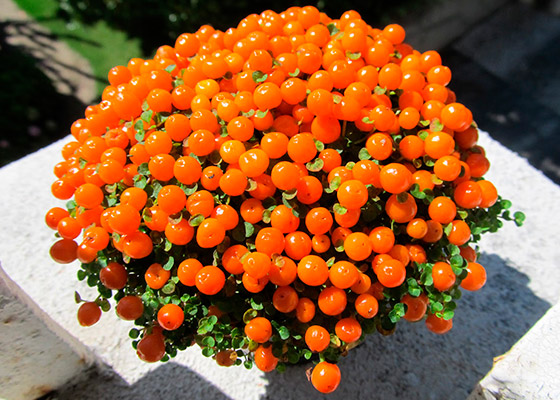
Sow seeds in late January or early February. Choose a wide container for sowing, since seeds need to be sown very rarely. Spread them over the surface of the soil and sprinkle a little with earth. Sowing a little with a wide board, spray abundantly with water from a spray bottle. Cover with plastic wrap and place in a warm, bright place. Ventilate the greenhouse every day, make sure that the ground in it is always moist.
Seeds germinate for 2-3 months.
Reproduction by dividing the rhizome can be carried out when transplanting nertera. Each part should be bulky enough for the new plant to become strong. A healthy plant cannot be obtained from overly small segments.For the first time, place the pots in a cool, shaded place.
Description of the flower
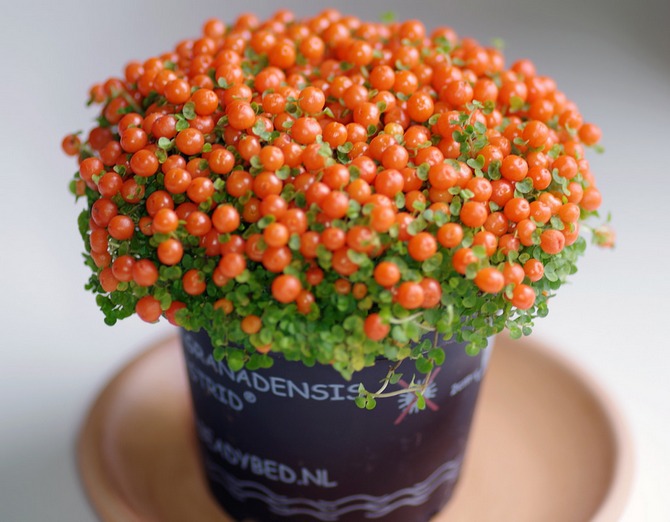
The stalks of nertera are similar to miniature vines - thin, rising to a height of no more than 2 cm, they spread along the surface of the earth, forming a miniature "rug". The leaves are small (no more than a centimeter), rounded, less often rounded-elongated, oppositely located on the stem. The flowers are small, indistinct, greenish-white, sometimes pale yellow. Fruits are small (pea-sized) berries of bright shades of orange, red and brown. The fruiting bush of nertera outwardly resembles dense scattering of cranberries or lingonberries. The plant bears fruit in winter and looks very optimistic and beautiful.
Important! Nertera berries are inedible because they are poisonous. Berries can also be dangerous for some pets.
Usually the plant is acquired for one season, at the end of fruiting it loses all its external attractiveness and therefore gets rid of it. However, when creating the conditions necessary for the plant, it can please caring owners for several years.
Nertera is considered a strong bioenergetic. She is able to increase the vitality of people. The strength of the energetic effect depends on the number of plants and their environment. The energy of the plant will increase if there are plants with bright flowers and lush foliage next to it.
The origin of hypoesthesia and its appearance
Hypoestes is a bright herbaceous representative of the Acanthus family. The homeland of a small shrub is the island of Madagascar, more precisely, its tropical rainforests. The plant also grows in tropical regions of Africa.
The birthplace of hypoesthesia is the rainforests of Madagascar
The plant is compact - 30 cm, but there are species that grow up to 60 cm and more. Possesses strongly branching semi-lignified juicy stems. During the season, hypoesthesia is able to reach its maximum size.
Poestes stems branch well
Hypoestes is grown exclusively for its beautifully colored leaves. The main dark green background is decorated with spots of white, burgundy, pink. If you form a bush correctly, then it will be covered with lush bright foliage. From a distance, hypoesthesia resembles Fittonia.
Hypoestes and Fittonia are somewhat similar
Opposite leaf plates of hypoesthesia are shaped like an egg with a pointed tip. Attached with petioles to the stems. Sheet size 7 - 10 cm. The edges are smooth or slightly serrated.
All the beauty of hypoesthesia is in its leaves
Flowers are small, tubular. Collected in heads or semi-umbrellas. In comparison with leaves, the flowering can be called modest. But the combination of purple flowers and vigorous green looks very harmonious.
Hypoesthesia flowers are unremarkable, although their color is very in harmony with the color of the leaves
It is not difficult to grow hypoesthesia at home - the plant is unpretentious. Still, a tropical guest needs a special approach. Hypoestes will be an excellent decoration for small rooms, and not only residential ones. It looks great in floral arrangements. The plant is grown in the garden as a ground cover, regular cutting will help maintain the desired height of the colored carpet.
Florariums also cannot do without a bright representative of the tropical flora. Hypoestes will get along well with companions and will be very comfortable in a specific microclimate. True, its rapid growth will have to be constantly controlled.
In the florarium, hypoestes feels great
Types and varieties of hypoesthesia
Botanists have counted more than 100 types of hypoesthesia. But out of all the diversity in indoor conditions, only 2 species have taken root, which laid the foundation for a large number of new varieties of this beautiful plant.
| Types and varieties | Description |
| Hypoestes blood red | 50 cm evergreen dwarf shrub. The dark green leaves of the leaves are enlivened by red peas and purple veins.The leaf blade is small - 8 cm long and 4 cm wide, and has an ovoid shape with a slight waviness at the edges. The flowers are light purple with a white throat, small in size. |
| Leaf spikelet hypoestes | A small shrub belongs to evergreens. The attractive appearance of the leaves is given by purple-pink spots on a green background. Inflorescences are axillary, solitary. Flowers are painted in lavender tone. It is the progenitor of many varieties with various forms. |
| Hypoestes Pink Veil | The non-green surface of the leaf is scattered with many pink spots, which vary in shape and size. |
| Hypoestes Splash white | The leaf plate with a slightly wavy edge is painted in white, on which green veins and edging are clearly visible. |
| Hypoesthesia Splash pink | Light pink leaf with dark green edging and veins. |
| Hypoestes Confetti Krasnoevino | Small crimson spots are scattered on juicy bright green leaves. |
| Hypoestes Spinous | Attracts gardeners in size - up to 1 m in height and 60 cm in width, and lush flowering. The flowers are painted in shades of pink and purple. Leaves are slightly drooping, green. |
Colored extravaganza of hypoesthesia: photo
Hypoestes blood-red
Nertera: home care. In detail
Caring for nerta at home must be carried out in compliance with certain requirements.
Bloom
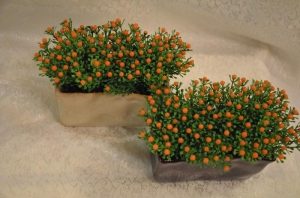 The flowering period of nertera occurs in late spring and early summer. At this point, the plant is covered with numerous greenish-white tubular flowers.
The flowering period of nertera occurs in late spring and early summer. At this point, the plant is covered with numerous greenish-white tubular flowers.
After a month, berries begin to set on the plant. By autumn, when ripe, they acquire a bright orange or red color.
They cover the bush so densely that leaves are practically not visible under them. They ripen unevenly, so the bush is constantly covered with a multicolored scattering.
Temperature regime
The homemade nerter plant should be grown at moderate temperatures. In the spring-summer period, + 20-22 ° C is optimal for it. By autumn, the temperature is gradually reduced to + 10-12 ° C. Coral moss should overwinter at + 8-10 ° C. From November March to March, he has a period of rest. During this period, you need to ventilate the room as often as possible.
As soon as a positive temperature is established outside, the plant is immediately taken out.
Spraying
When caring for nerta at home, systematic spraying is necessary. A high level of humidity is especially necessary during the period of intense growth from March to September. For spraying, pre-settled water at room temperature is used.
When flowers and berries appear, it is better to reduce or stop spraying altogether. To maintain the required moisture level, containers with water are placed next to the plant or the pot is placed on a layer of wet expanded clay.
Lighting
The domestic nerta needs a lot of bright, diffused light. It develops well in partial shade. The plant should be protected from direct sunlight.
In the autumn-winter period, it is advisable to organize supplementary lighting. For this, ordinary fluorescent fluorescent lamps are suitable. The light source is placed at a distance of 40-50 cm.
Watering
 During the period of intensive growth, the plant is watered moderately.
During the period of intensive growth, the plant is watered moderately.
The top layer of the soil must dry out.
In winter, watering is reduced to a minimum, but the substrate must be constantly slightly damp.
With the onset of growth, watering is resumed.
Pot
Coral moss has a shallow root system. Therefore, a wide and shallow pot is best suited for it. When choosing, preference should be given to plastic containers. They better retain soil moisture.
Priming
Nertera grows best in a sandy, water-permeable substrate. In it, the probability of root drying out is reduced to a minimum.To prepare the soil mixture, sod land is used as a basis with the addition of humus and sand. The main criterion for coral moss is moisture capacity. Therefore, vermiculite or perlite can be added to the substrate to improve performance.
Top dressing and fertilization
Coral moss is specific to fertilization. It reacts sharply negatively to excess nitrogen, but at the same time it needs a large amount of phosphorus. Fertilizers are rarely applied, no more than 1 time per month, and then in a half dose. During the rest period, feeding is stopped altogether.
Transfer
 The nertera is transplanted in early spring.
The nertera is transplanted in early spring.
The plant is simply gently transferred into a slightly larger pot. There is no need to compact the earth around the roots.
When transplanting, one should not forget about arranging expanded clay drainage. At first, the plants are kept in partial shade and coolness.
After the start of active growth, they are rearranged to a more illuminated place.
Pruning
Nerters do not carry out continuous pruning. For plant rejuvenation, the division of overgrown bushes is used. In the spring, dry and elongated shoots are simply removed from the bushes using sharp scissors.
Dormant period
From late October to November, coral moss has a pronounced dormant period. During it, growth completely stops.
During this period, it is very important to ensure a lower temperature. This will save the plant.
How to deal with nertera diseases and pests
When growing this flower, problems with diseases or insects may arise:
- gray mold (caused by moisture in the leaves),
- root rot (the reason is waterlogging),
- the appearance of spider mites (the reason is too dry and hot air),
- other insect pests (source - neighboring houseplants).
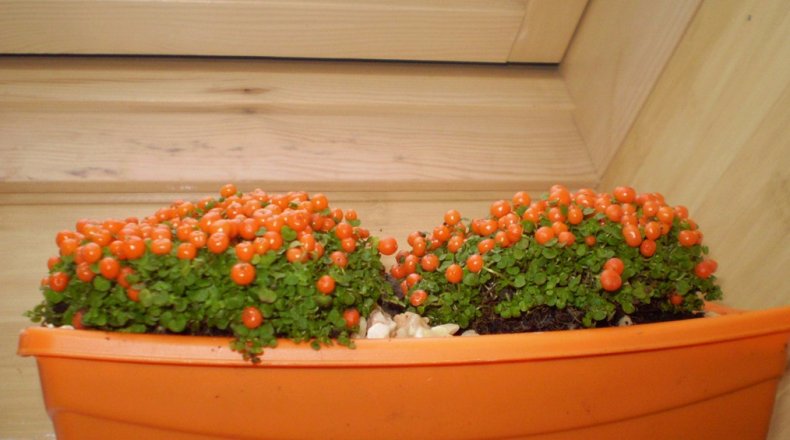
How to deal with major diseases:
- If a lot of young leaves and shoots appear on the nerter, but the flower does not bloom and there are no fruits on it, this means that the plant is too hot and dry. The pot must be moved to a room with a lower temperature and periodically humidified by spraying moisture into the air.
- Grass shoots rot at the point of contact with the soil - most likely, this is the result of waterlogging, and the soil in the pot has turned into a "swamp". The plant should not be watered for 7-10 days. Watering (moderate) is resumed only after the surface of the soil in the pot dries up.
- The tips of the grass shoots become brown and die off - the flower was burned by the sun's rays and the soil in the pot is very dry. Nerter needs to be rearranged in a slightly shaded place and well watered.
- The leaves of the perennial became lethargic and lost their turgor - the flower was occupied by harmful insects. It is necessary to treat the plant with any insecticide. How to carry out the procedure: put a plastic bag on top of a pot with a perennial, then the plant is sprayed with insecticide under the bag. He is left in this state for half an hour. Then (if there is no frost), the plant must be taken out to the balcony or outside, remove the bag and ventilated well for 5 minutes.

Caring for the pseudo-erantemum at home
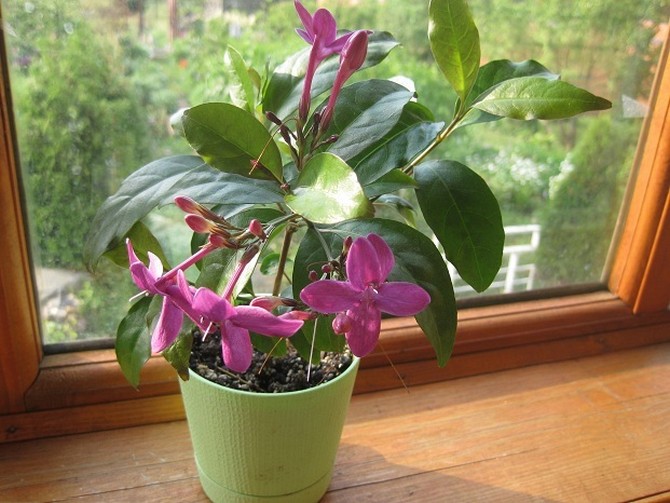
Illumination
Bright lighting is necessary, but at the same time it must be diffused. You will need shading from the direct rays of the sun. In winter, such a plant must be provided with good lighting. In this regard, experts advise using supplementary lighting with special fluorescent lamps. It is recommended to place such shrubs on east and west facing windows. When placed on a south window, shading from direct sunlight will be required. If the lighting is poor, then the leaf plates will lose their variegated color. If the lighting is too intense, then the leaves of the pseudo-erantemum will acquire a rich red tint, but it will itself stop growing and developing.
Temperature regime
In summer, the plant thrives best at temperatures between 22 and 25 degrees.In autumn and winter, the temperature should not drop below 20 degrees. This plant reacts negatively to sudden changes in temperature, and it should also be protected from drafts.
Humidity
For normal growth and development, high humidity is required. In this regard, the plant should be moistened with a sprayer regularly and throughout the year. With a warm winter, you need to spray the foliage more often, since the heating devices dry out the air. To increase the humidity, you can also pour expanded clay, pebbles or sphagnum into a wide pan and pour a little water. However, make sure that the bottom of the container does not come into contact with the liquid. For hygienic purposes, the leaves can be wiped with a damp sponge.
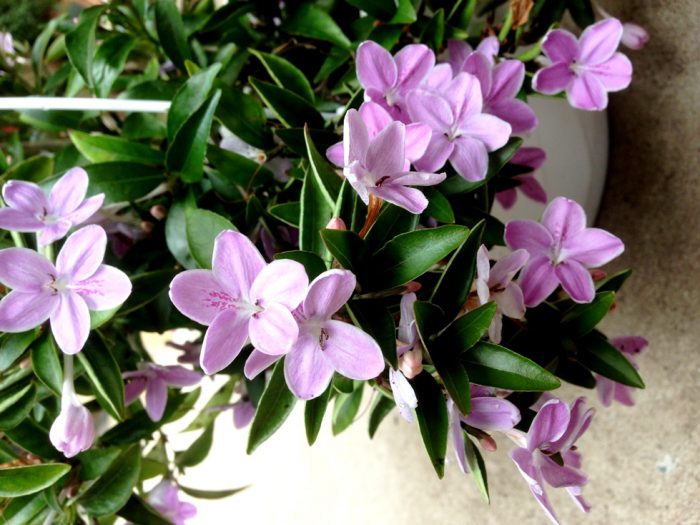
How to water
Watering should be abundant throughout the year. It is produced as soon as the topsoil dries up. As a rule, the potted substrate dries out relatively quickly, and that's because the pseudo-erantemum evaporates a large amount of moisture through the foliage. Make sure that there is no overdrying of the soil, otherwise the plant may shed all the leaves. When water stagnates in the soil, rot can form on the root system.
Top dressing
Top dressing is carried out in the spring and summer once every 4 weeks. For this, it is recommended to use fertilizers for indoor plants, which have a high potassium content. This will help make the color of the leaves more saturated. In autumn and winter, fertilizers do not need to be applied to the soil.

Transplant features
This is a fast-growing plant, in this regard, the transplant should be carried out once a year in the spring. In the process of transplanting, it is necessary to prune the roots, which also differ in rather rapid growth. Suitable soil should be light, slightly acidic, or neutral. Do not forget to make a good drainage layer at the bottom of the container. The new container must be 2 sizes larger than the old one. If the pot is too small, then this can cause all the leaves to die off.
Pruning
In the process of growth, the foliage from the bottom falls off, which is why the lower branches are bare. To fix this somehow, you need to carry out systematic pruning and pinching of the branches. This will allow you to get rid of bare branches, as well as increase the branchiness of the plant, which will have a beneficial effect on its appearance.
It should be noted that lateral shoots can grow exclusively upward. To improve the appearance of the bush, experienced flower growers recommend bending the branches to the surface of the soil using a flexible cord, while one end of it must be tied around the container.
Reproduction methods

It can be propagated by both semi-lignified and herbaceous cuttings.
For rooting to be successful, you need a mini greenhouse. The soil temperature must be constantly maintained at about 25 degrees. Until that moment, until the cutting has roots, and it begins to grow, it is strictly forbidden to ventilate the greenhouse. Stimulant hormones are often used for rooting.
To root such cuttings, you can take a glass of water. But it must be placed in a very warm place (25 to 28 degrees).
Pests and diseases
Watering too much can cause rot on the roots.
At low air humidity, spider mites very often settle on the plant. And even if the rules of care are violated, scale insects, mealybugs and whiteflies can settle on the pseudorantemum.
Possible difficulties
- Flying leaves - overdrying an earthen coma.
- The tips of the leaves dry out - low humidity.
- The tips of the leaf plates dry out, and brown spots appear on the surface - intense lighting.
- The leaves turn yellow and die off - dry air, stagnant water in the ground.
Nertera is a catchy little one with a cheerful character
Nertera is a strikingly spectacular plant. Bright, colorful and festive, she seems to be all wrapped up in a festive outfit.Some unconventional practices even endow nertera with magical properties, but it's hard to say whether nertera really increases activity and energy. But the fact that one type of pots with juicy greens and a bright scattering of berries raises a smile is undoubtedly.
Nertera granadensis, we know not under a specific name as the Grenada or Granada nertera, but under the popular nickname "coral berries" or "coral moss" - a ground cover of traditionally small height. Lush cushions form long, flexible shoots that hang elegantly from the edges of the pot. In length, they are limited to a modest 20 cm, but are so densely located that they fully compensate for their modest size.
The greenery of nertera seems curly and elegant, incomparably fun. Leaves are rich herbaceous, rounded, about 0.5 cm long and wide. And the height of the plant itself will never exceed 10 cm (and even then in very elongated specimens).
Nertera blooms in April and May, but it is not grown for the sake of nondescript miniature stars of flowers. The main show of this baby begins after the end of flowering, when magnificent, perfectly round and glossy fruits begin to form on the plant, and then change color. They really seem to be beads, coral, bright and extremely ornate. Charming beads keep on nertera bushes from August until winter, while many elegant berries perfectly enliven the autumn and winter, rather boring interior.
And after the change of color from white and cream to yellow and orange of various shades, and then - to the "final" red, it is impossible not to follow the admiring gaze. Due to the fact that berries of a completely different color flaunt on the plant for several months, nertera seems even more bizarre. The berries reach 1 cm in diameter, and their distinctive feature is not so much a bright color as a glossy sheen.
Nerters, despite their beauty and friendliness, contain poisonous and explosive substances. So it's better to refuse the temptation to run your hand over the curly pillow and touch the berries. True, these plants are not so aggressive as to transplant them in a mode of enhanced protection.
Note: In addition to the Granadskaya nertera, you can also find the pressed nertera on sale. Her main thing is greenery, and the berries are only "piecewise" decorated with variegated bushes.
 Nertera Granadskaya. Puffy
Nertera Granadskaya. Puffy
Growing problems
The big difficulty is that nertera cannot withstand the indoor air temperature in winter (above 20 degrees). This does not allow the plant to enter a dormant state, therefore, growth continues, the stems are stretched, and the shoots are bare. Often, problems are caused by over-watering: the plant rots. With insufficient watering, it dries up.
Nerter needs to be constantly updated, to create cool conditions for it in winter, and to water it correctly. If given enough attention and care, nertera can turn out to be the most elegant plant among those already in the house.
Due to the difficulties associated with leaving, nertera is often bought when the berries have already formed (at the beginning of fruiting) and are kept at home until the last berry falls. The plant is then discarded.
And for those who like to know more, we suggest that you familiarize yourself with the video about nerter
Description
The culture is characterized by not too fast growth, producing a maximum of 2-3 new leaves with a diameter of about 60 cm in one year. After 7-8 years, a young seedling reaches a height of more than 2 meters.
Vine leaves are green, large, leathery, heart-shaped. Young leaves are whole, and adults are deeply dissected and with holes in the leaf plate.

In its natural habitat, liana climbs tree trunks with the help of long aerial roots, therefore, in pots, it requires the use of supporting structures.
The stems are attached to the support using wire or hemp rope.The support must be strong and stable so that the plant does not turn over under the weight of the growing shoots.
The houseplant Monstera belongs to the Aroid family, so the flowers it forms are typical in appearance for many other members of this family, such as anthurium or spathiphyllum.
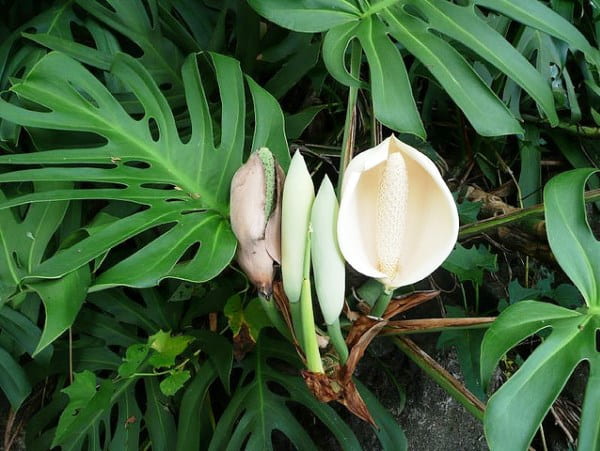
Under favorable conditions, adult specimens can bloom annually. The monumental bisexual inflorescence has the shape of an ear surrounded by a large white bracts.
After flowering, the monstera produces cone-shaped, aromatic and juicy fruits with a banana-pineapple flavor. They are edible only when ripe. Fruit ripening can take a year or even longer.
Is monstera poisonous or not? All parts of the plant are moderately toxic to humans, with the exception of ripe fruits. This is the result of calcium oxalates (oxalic acid) present in the sap of the plant. In contact with mucous membranes, the compounds cause irritation, burning and allergic reactions.
Varieties
There are several interesting species of nertera that are especially popular with plant breeders. Nertera granadenzis mix bears fruit with bright orange berries. They remain on the bush during the fall, and some remain until winter. Granadenzis leaves are small and light green. Nertera astrid has small leaves and berries of a red-orange hue. The fruits are placed so close to each other that from a distance the plant resembles a colorful ball.


Nertera pressed is a perennial with a herbaceous stem. At the end of the flowering process, the plant is covered with orange berries, which remain on the inflorescences until late autumn. Due to the fact that the stem tilts towards the ground, a grass “cushion” is formed directly in the container or pot. The fruits of nertera are inedible. Nerthera Balfour is a low plant covered with round leaves. The length of herbaceous stems reaches 20-25 centimeters. The star-shaped flowers have no decorative value. The fruits are shaped like orange droplets.
Nertera Granada has thin, creeping stems and very small leaves, the length of which varies from 3 to 7 millimeters. Flowering begins in late spring - early summer. Nertera flowers have a small diameter and a yellow-green color. The berries are colored in the color of a wild orange. Their characteristic feature is considered to be the ability not to fall off the bushes for a long time.
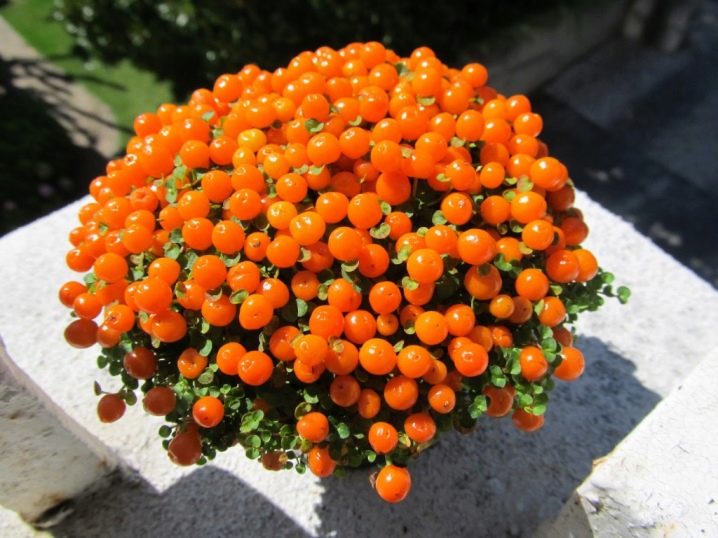
Nerthera ciliate does not grow luxuriantly. As a rule, the diameter of the bush reaches only 25 centimeters. Both flower petals and leaves are covered with miniature cilia. The lanceolate leaves are covered with green skin, and the small flowers are colored a mixture of white and green. Rounded berries attract breeders with their bright color. Nerter Cunningham pleases its owners with bright red fruits. The herbaceous stems form a cap that reaches 20 centimeters in diameter.
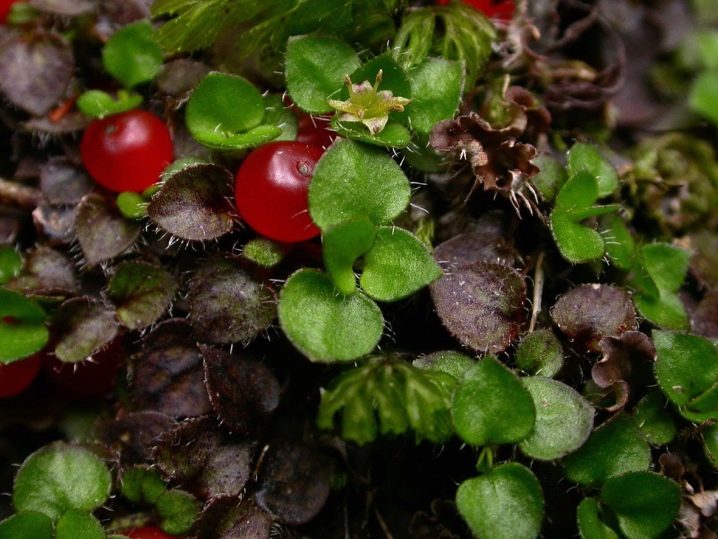
Main types description
Bussengoltia has several species, but the most widely grown among gardeners is the cordifolia anredera. The homeland of growth is considered to be the tropical forests of Ecuador, Brazil, Argentina and even Mexico.
Heart-shaped
A feature of this species is the heart-shaped leaves with a pointed end of small sizes, which grow alternately on liana-like shoots. The tubers have a pineal shape and are quite fragile. Small but fluffy flowers of milky shades are collected in brush-like inflorescences, which are located in the leaf axils. Also in these sinuses, very small nodules can form, which have excellent vitality.
Bubbly
Also, in nature, you can find a bubbly anredera along roads and fences, which with its clinging shoots can reach a length of up to 8 meters. The leaves are egg-shaped, the flowers are creamy and gather in long (up to 70 cm) racemose inflorescences.
Spicate
A feature of the spike-shaped anredera is considered to be a pinkish shade of buds, which by the end of flowering changes to black.
Sanchezia care at home
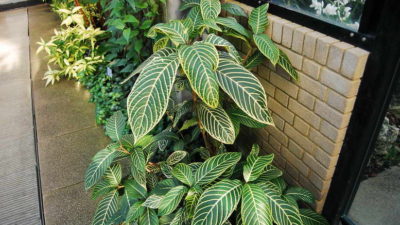
Lighting
The plant needs bright light. However, he must be absent-minded. It is necessary to protect the sanchetia from direct sunlight on its leaves. It is forbidden to put the flowerpot on the windowsill when it is a warm season outside.
Temperature regime
The shrub is very fond of warmth. It is recommended to keep it indoors at a temperature of 15 to 24 degrees Celsius. During winter, you need to ensure that the temperature does not drop below 12 degrees Celsius.
How to water?
In spring and autumn, watering should be abundant, and with the arrival of cold weather - moderate. Water the plant twice a week.
Humidity
The most important rule when growing this plant at home is high air humidity. To increase it, you should additionally spray the shrub in the morning or in the evening. You can also place the flowerpot on damp pebbles or near the aquarium.
It is very important to ensure high air humidity in hot summer and winter, when heating devices are on next to the pot. If the humidity is low, then the plant will begin to dry the tips of the leaves, so it loses its decorative effect.
How to fertilize?
Fertilizers need to be applied during the active growth of the plant - in spring and summer. Complex fertilizers are most often used. To stimulate the growth of leaves, it is necessary at the beginning of spring to apply fertilizers in which a high percentage of nitrogen content is present, after which you can switch to complex feeding.
Planting and transplanting

The transplant must be carried out every year. It does not depend at all on the age of the sanchezia. It is customary to transplant in the spring, but if there is a need to slightly adjust these terms, then nothing terrible will happen.
If the plant was recently brought from the store, then after a week it needs to be transplanted. In this case, the time of year does not matter. The soil should be loose and nutritious. Many gardeners use a heather-based mixture. It is very difficult to make such soil on your own, since the main component is not always at hand. Therefore, it is recommended to purchase a ready-made one. For example, a mixture for azaleas is great.
Reproduction
Plant propagation is carried out in two ways:
- seeds;
- cuttings.
It is quite difficult to propagate santhecea with seeds, because it is simply impossible to get them on your own. In the natural environment, hummingbirds pollinate the shrub. If you buy them in a special store, then there is a risk of purchasing seeds that have long lost their germination.
The cuttings, the length of which is about 15 cm, must be cut off the lower leaves, and the large upper ones must be shortened in half. The cut must be immediately treated with a root formation stimulator, after which the cutting can be planted in perlite, vermiculite, or in a mixture of peat and perlite. The planting should be covered with cellophane, while maintaining the temperature at about 24 degrees Celsius. Cuttings need to be sprayed every day.
Diseases and pests
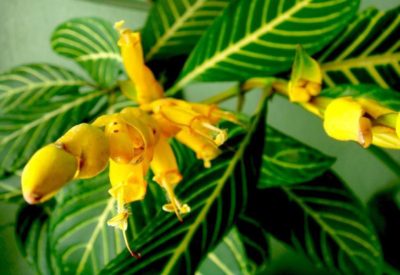
If there is constant stagnation of moisture, then the plant may develop root rot.
The succulent shoots of the shrub are very popular with the scale insect and aphids. They are usually found on the underside of the foliage along their fleshy veins. You can get rid of pests by treating the foliage with a special soap solution.
If this does not help, then you need to purchase a modern insecticide. Processing is carried out twice with a break of one week. After that, insects will not return for a long time, even if the plant is in the garden.
Some of the consequences of improper care and maintenance:
- Excessive dryness of the air, soil and lack of lighting will lead to leaf fall.
- Brown spots on foliage can be caused by sunburn.
- Low temperatures and high humidity will cause leaves and stems to rot.
- If the plant grows slowly and has small leaves, then this indicates a lack of nutrients.


